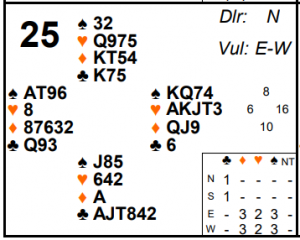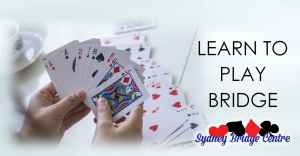City and Canada Bay – Monday Morning 14th October 2024.

Board 25 last week saw one or two East West pairs make game but it was more usually a partscore battle.
After pass from North and 1♥ from East the first question is whether South overcalls 2♣ or not. I would – you have a decent 6 card suit which you would want partner to lead and a bit of shape and it takes up bidding space (e.g. removing a 1♠ response). But it’s not without risk – clubs could sit over you and 3 low hearts is a very bad holding knowing you will probably receive a heart lead after East’s opening.
West has the right sort of shape to double after 1♥ 2♣ but he’s too weak to act on his own at the 2 level – especially with a singleton in partner’s suit and the ♣Q being of very dubious value. Now North can make things tougher for he opponents by raising to 3♣. He would compete there anyway so he’s better off doing so immediately rather than allow the opponents more room to compete (these days it’s very unlikely 2♣ will get passed out). North is also safe from encouraging partner too much with the raise because his hand is already limited in two ways – first he’s a passed hand, second he could have made a cue raise by bidding 2♥ to show a better hand.
Had 2♣ come round to East he has a very easy re-opening double (either to compete or to cater for partner holding a penalty double of clubs). After a raise to 3♣ East is under a bit more pressure (the raise makes it much more likely partner is weak because the chance of him having a penalty double of clubs is now very low) but his hand is still strong enough to double here. West will them bid either 3♦ or 3♠ – personally I’d bid 3♠ at pairs but 3♦ at teams (you need to play the higher scoring major contract at pairs but there’s a small risk partner only has 3 spades so 3♦ may be a safer contract than 3♠ which is more important at teams).
One or two East West pairs reached all the way to 4♠. Possibly after finding a fit East liked his hand so much that he bid one more. Or maybe South didn’t overcall so West could respond 1♠. Now East will raise enthusiastically (see advanced section for some options here).
Let’s consider the play. First to a spade contract which will usually be played by West. One way the defence could hold it to 9 tricks is by leading a diamond, then South underleading ♣A to North so he can play ♦K and a diamond ruff. In practice of course that’s unlikely. North is far more likely to lead a club. Now South’s best defence may be to continue clubs to attack the trumps in the East hand which may be later entries to a long heart. Or to switch to trumps to reduce the ruffs that can be taken in each hand. Although declarer only has 3 losers on the face of it (♣A and 2 diamonds) there’s now a lot of work for him to do. Drawing 3 rounds of trumps won’t work because that would leave him only one which will be forced out once South wins ♦A – but declarer then still has at least one diamond loser. A cross ruff of hearts and clubs might get you to 9 tricks but not 10 (see advanced section for why not).
If East West don’t compete to 3♠, then they might defend 3♣ by South. West will naturally lead a heart and East will probably win ♥10 at trick 1 and follow up with ♥A to find out the layout in that suit. The defence should pretty easily come to 2 spades and 3 hearts for 1 off. But they can in fact take the contract 2 off in two ways – can you see what they are? See advanced section for the answer.
Key points to note
- A decent 6 card suit is usually worth overcalling at the 2 level but it can still backfire.
- If you are prepared to raise partner’s overcall and RHO passes or doubles you are better off raising immediately rather than waiting – this puts more pressure on the opener to make a decision to defend or bid on.
- If you are considering cross ruffing, count your potential tricks – and whether you have sufficient entries to get all the ruffs. Sometimes you may not be able to come to enough and will have to adopt a different line of play.
- Be alert to possible extra tricks in the trump suit when defending – trump promotions come up quite often!
More advanced
If the auction had started P 1♥ P 1♠ P what should East rebid? His hand has now become pretty powerful with good 4 card support, a strong 5 card side suit and a shortage. He’s definitely worth 3♠ which West should pass as he’s dead minimum and has a singleton in his partner’s first suit. But, depending on your methods, East might be able to rebid 3♣ as a “mini-splinter”. This would be very descriptive. However, the more common treatment of a jump rebid like this is natural and strong. Playing them as mini-splinters (a jump to the 3 level below 3 of your agreed major) provides a good picture of your hand and, like all splinters, allows partner to judge if his honours are likely to fit well with your hand. They can allow some quite light games or slams to be reached. It is, however, important to appreciate the pro’s and con’s of mini-splinters. If you play an uncontested auction 1♥-1♠-3♣ as a mini-splinter then how are you going to bid a strong hand with hearts and clubs? You basically have to rebid 2♣ which means you need to make a 2♣ rebid forcing if it could be done on a 20 point hand. That itself has downsides because now a really weak responding hand has to dredge up a bid after 1♥-1♠-2♣ in case opener is really strong. So a raise to 3♣ in this sort of auction is no longer invitational, it might have to be done on a bare minimum. You therefore gain more accuracy in auctions where you agree the major but you lose elsewhere – like any convention there is a trade off.
I said a cross ruff in 4♠ wouldn’t be enough – but it’s useful to consider why. If you play to ruff 2 clubs in the East hand you are going to score those ruffs, ♥AK and all 4 trumps in the West hand – which is only 8 tricks. To score a 9th trick via ruffing would require you to be able to take 3 ruffs in one hand and draw trumps from the other. West doesn’t have enough clubs for that to be possible – you’d have to consider ruffing 3 hearts in West. That might get you those 3 tricks, ♥AK and 4 trumps in East. But if the defence have started with clubs then you may not have enough entries to East to do that. Either way the most you can score is 9 tricks. Once you start cross-ruffing, it’s very likely the defence will switch to trumps as soon as you let them in as well which will then remove a possible ruff from both hands! So the net conclusion from all that is the only way you can come to 10 tricks is to score some diamonds – hence the side suit will need to be played on. It’s often worth counting tricks like this as it can give you a clue how the hand needs to be played.
So how do East West beat 3♣ by 2 tricks? Two ways:
- East wins ♥10 and plays ♥AK and a 4th round. This promotes a trump for West (either immediately or if declarer ruffs with ♣A then West’s ♣Q9x is now worth a trick as he can cover ♣J). It won’t help declarer to discard on the 4th heat because he’s only discarding his 3rd spade and there are still 2 spade losers.
- East wins ♥10 and cashes ♥AK on which West discards 2 spades. Now East switches to a spade. West wins, returns his now last spade to East who plays a 3rd round of spades. West ruffs with ♣9 forcing the ♣K from dummy and promoting his ♣Q into a certain trick.
Lastly, which of these two is the better defence? The second. Why? Because it would also work if West’s clubs are ♣Q8x. The first would not work with that holding as declarer ruffs with ♣A and can run his ♣J109 through West and avoid losing a trump trick.
Julian Foster (many times NSW representative) ♣♦♥♠




Thanks Julian.
Lots of thoughts